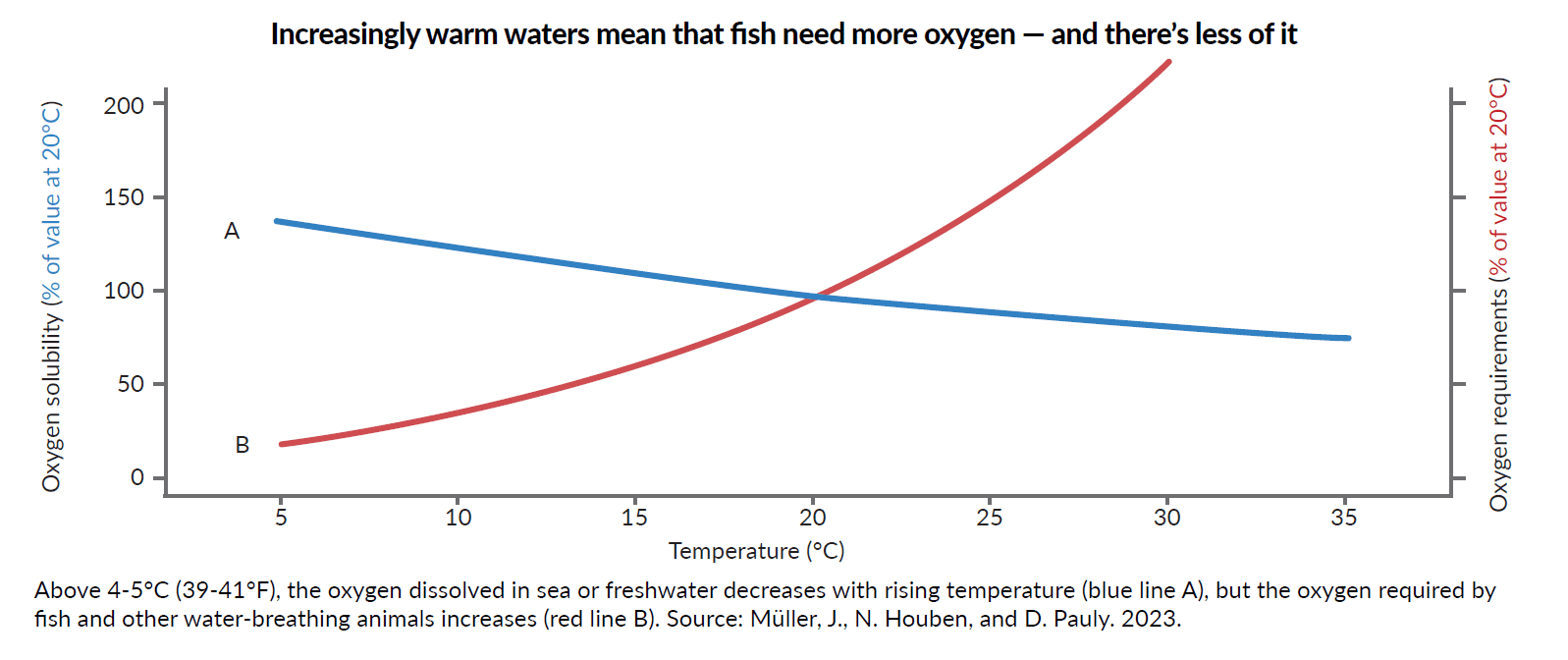April 18, 2024
Ask Dr. Pauly: What are marine heat waves?
BY: Daniel Pauly
Topics:
Marine heat waves are what you think: periods of temperature well above the level expected for the season that last for a while. If the temperature of the water along a coast is, for example, 3 – 5°C (about 5 – 9°F) above the temperature you expect, lasting for a week or two, then you have a marine heat wave.
Generally, the consequences of a marine heat wave are much greater than those of a heat wave on land. This is because most terrestrial animals – including humans – are used to experiencing a wider range of temperatures than marine animals. Also, many marine animals already live at a temperature close to the maximum they can tolerate. But marine heat waves are not like terrestrial heat waves. Instead, they are the marine equivalent of forest fires.
Most marine and freshwater animals breathe water, which, unlike air, contains less than 1% oxygen. That’s less oxygen than at the top of Mount Everest. Temperature increases make this worse because warmed water contains even less dissolved oxygen than cold water (see blue line A in Figure 1).
Most of these animals — including fish, lobster, and squid — can tolerate a range of temperatures, but their respiration is affected. They need far more oxygen at high temperatures (see red line B in Figure 1). This is because their body temperature also increases, which leads to the proteins forming their tissues ‘denaturing’ (i.e., falling apart) and needing to be replaced.1

So, when a marine heat wave hits, fish and other water-breathers require more oxygen, but the water around them contains less. They try to escape, as animals in a forest would flee a forest fire, but they can’t, and after a few hours or days, they die.
Marine heat waves are becoming more frequent. Well-documented marine heat waves hit the West Coast of the United States and Canada from late 2013 to early 2016 (the years of ‘The Blob,’ a enormous mass of warm water)2 and Western Australia from December 2020 to January 20213.Yet again, in June 20214, marine heat waves struck the West Coast of the U.S. and Canada, where the stench of an estimated billion decaying shore animals, notably clams, mussels, and sea stars, wafted along the coast of British Columbia for days.5
Heat waves and low-oxygen events that kill fish are even more frequent in freshwaters, so much so that the Fish and Wildlife agencies of various U.S. states have equipped their field personnel with practical guides. These guides state that if there are large dead fish on, for example, a small lake, they presumably died of lack of oxygen, or “hypoxia” (usually caused by unseasonably high temperatures).On the other hand, if the dead fish are mainly small, a poison, such as an insecticide, is likely responsible. 6
The reason large, older fish and invertebrates are more susceptible to low oxygen levels is because these individuals have less gill area (i.e., respiratory area) per body weight than young, smaller ones. So, small individuals survive longer when the oxygen declines and/or temperatures rise. Nevertheless, marine heat waves can last long enough and are sufficiently hot to render the different susceptibility levels among small and large water-breathers irrelevant – they all will die.
Marine heat waves and their freshwater counterparts are becoming more frequent, and if our greenhouse gas emissions continue to increase, they will also increase in intensity and duration. Marine heat waves are a window to our future – just as forest fires are. If we want vibrant oceans full of life, we must join the fight to reduce greenhouse gas emissions to net zero.
1, 6 Müller, J., N. Houben, and D. Pauly. 2023. On being the wrong size: what is the role of body size in fish kills and hypoxia exposure? Environmental Biology of Fishes, https://doi.org/10.1007/s10641-023-01442-w
2 https://www.fisheries.noaa.gov/feature-story/new-marine-heatwave-emerges-west-coast-resembles-blob
3 https://climateextremes.org.au/marine-heatwave-in-western-australia-december-2020-and-january-2021/#:~:text=Temperatures%20reached%202%2D3%E2%88%98,fisheries%20may%20yet%20be%20felt.
4 https://www.science.org/doi/10.1126/sciadv.abm6860
5 https://www.theatlantic.com/science/archive/2021/12/extreme-heat-baking-sea-animals-alive/620904

